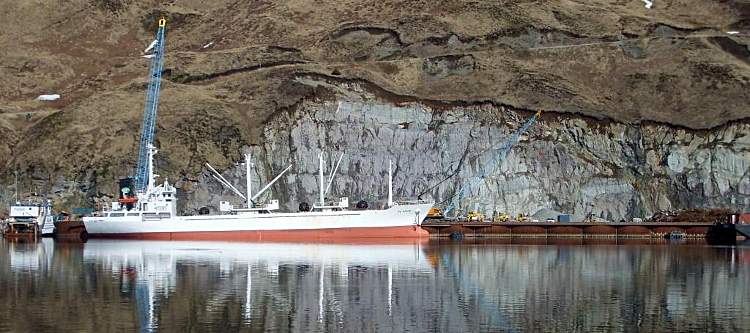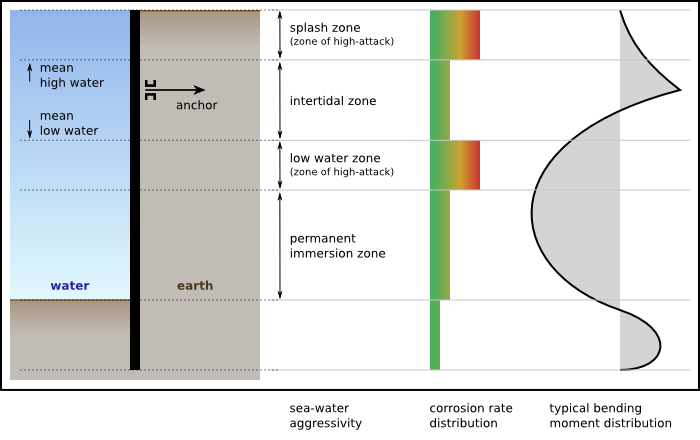
Once you are familiar with the science behind rust and corrosion, you may be interested in our article on A690 Mariner Steel.
From Recommendations of the Committee for Waterfront Structures Harbours and Waterways, 7th Edition, EAU 1996 Section 8.1.8.1, page 292:
When in contact with water and at the same time in the presence of oxygen, steel is subject to the natural corrosion process. Material abrasion from corrosion depends on the one hand on local (e.g. hydrological) conditions, on the other hand on local (vertical) position regarding the water line. The latter means the different zones of corrosion are formed (fig. R 35-1 on pg. 293). The degree of corrosion intensity is the decrease in thickness (rusting in mm), i.e. the decrease of the wall thickness, e.g. of a sheet pile. Referred to the time unit, one speaks of the rusting speed (rusting rate in mm/a). Investigations of steel sheet piling with differing service lives indicate that the rusting speed decreases in time resulting from the formation of a cover layer, unless this cover layer is constantly destroyed by mechanical or chemical stress. Accordingly, when rating the decrease in thickness or rusting speed, the design period respectively service life of the member must also be stated.
Contrary to many misconceptions, steel sheet piling durability concerns are minimal for most applications simply because sheet piling is usually over-designed to begin with, due to the use of a very high safety factor. This inherent factor obviously takes the natural and inevitable aspect of corrosion into account. However, in salt water applications (or, in some very rare cases involving polluted soils), it is recommended that the engineer design the project using the sacrificial steel method and only then consider if a protective coating will be necessary.
a. The highest corrosion rate is usually found in the (sea water) splash zone or in the low water zone. However, in most cases, the highest stresses are in the permanent immersion zone. At right is a reproduction of a graph found in Recommendations of the Committee for Waterfront Structures Harbours and Waterways, 7th Edition, EAU 1996 Section 8.1.8.3, Fig. R 35-1, page 293.
b. The area of most concern is the low water zone because it is closest to the area of highest stresses. For salt water applications, therefore, it is recommended that you coat the sheet pile structure (or employ cathodic protection) down to 1.5 meters to 2.5 meters below the mean low water so that the critical low water zone is protected.
Accordingly, Recommendations of the Committee for Waterfront Structures Harbours and Waterways, EAU 2004 Section 8.1.8.4, page 320:
According to available experience, coatings can delay the start of corrosion by more than 20 years.
The highest corrosion rate is usually found at the splash zone or at the low water level. However, in most cases, the highest stresses are in the permanent immersion zone as the Eurocode states (BS EN 1993-5: 1997 and BS EN 1993-5: 2007).

The US Army Corps of Engineers’ Design of Sheet Pile Walls Engineer Manual is unambiguous in its general preference of steel over concrete for sheet pile walls: “The designer must consider the possibility of material deterioration and its effect on the structural integrity of the system. Most permanent structures are constructed of steel or concrete. Concrete is capable of providing a long service life under normal circumstances but has relatively high initial costs when compared to steel sheet piling. They are more difficult to install than steel piling. Long-term field observations indicate that steel sheet piling provides a long service life when properly designed.” (Section 2-2).
One of the most effective ways to achieve a good corrosion protection is to increase the thickness of steel sheet piling. With low maintenance for the lifetime calculated here is a long-term reduction in maintenance costs and is thus made of economic sense. This will be limited where no profile with greater steel thickness on the entire cross section can be chosen, or just a flat steel can be be welded on even surface areas, like the back or web of steel sheet piles.
In both cases a very high risk remains to the structure being dangered by corrosion on the non-reinforced steel areas.
For example for quay walls of the Port of Hamburg is therefore generally a minimum steel thickness of 12mm for all components required exposed to the salt water. Likewise for the connectors of combined sheet pile walls.
A perfect alternative is here shown with the O-Pile system (= contiguous pipe wall).
Pipes offer higher bearing capacities and have lower tolerances than hot rolled steel sheet piles .
Therefore an extension or splicing can be realized more easily.
Hence, for example, a pipe with a constant outer diameter and increased steel thickness for the upper portion, can be spliced together to a customized pipe section below slim and above thick.
The matching connectors WOM/ F-XL are, as required in Hamburg, overall 12mm thick. The O-pile system allows globaly an optimum adaptation to different corrosion rates without wasting steel.
If design considerations play a role, or other project conditions require a coating, a selection guide can be found at the Federal Institute for Hydraulic Engineering, Karlsruhe / Germany. This table shows important criteria for environmental and durability, such as solvent content, abrasive resistance, long-term performance and suitability for use in combination with cathodic corrosion protection. Also can be seen which system fulfills the requirements with the minimum layer thickness, i.e. meet costs.
Enter your wall dimensions and the values below will adjust automatically.
| retaining wall type | construction days | total cost | cost per linear ft | cost per square ft |
|---|---|---|---|---|
| Steel Sheet Pile Wall | 47.69 | |||
| Soldier Pile and Lagging Wall | 90.45 | |||
| Concrete Modular Unit Gravity Wall | 76.18 | |||
| Mechanically Stabilized Earth Wall | 95.58 | |||
| Cast-In-Place Reinforced Concrete Wall | 136.09 | |||
| Slurry Wall | 210.60 |
Approximate cost and construction time for different wall types is based on 2009 RSMeans pricing for the US and extrapolated from the 2009 NASSPA Retaining Wall Comparison Technical Report,